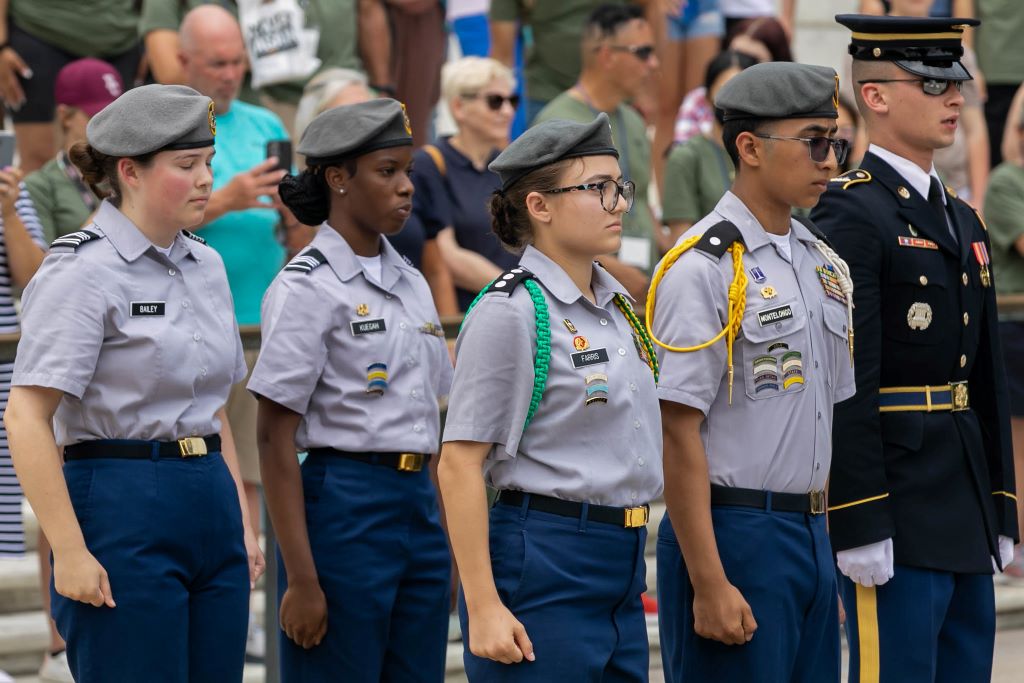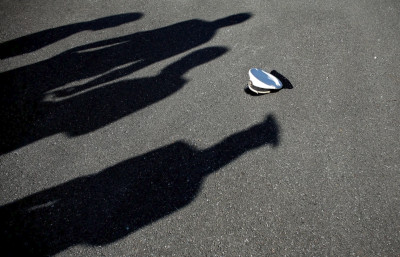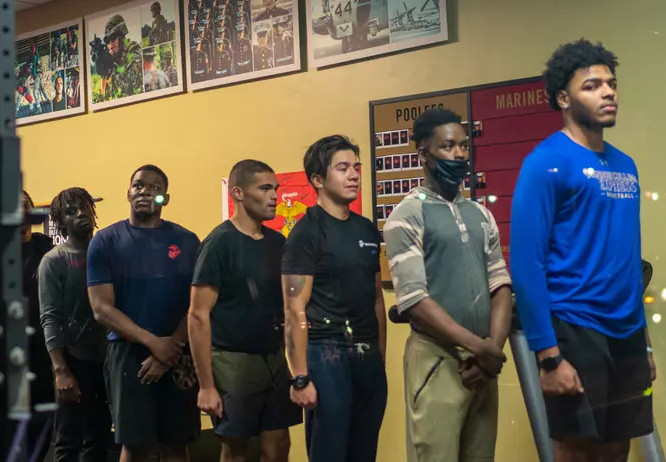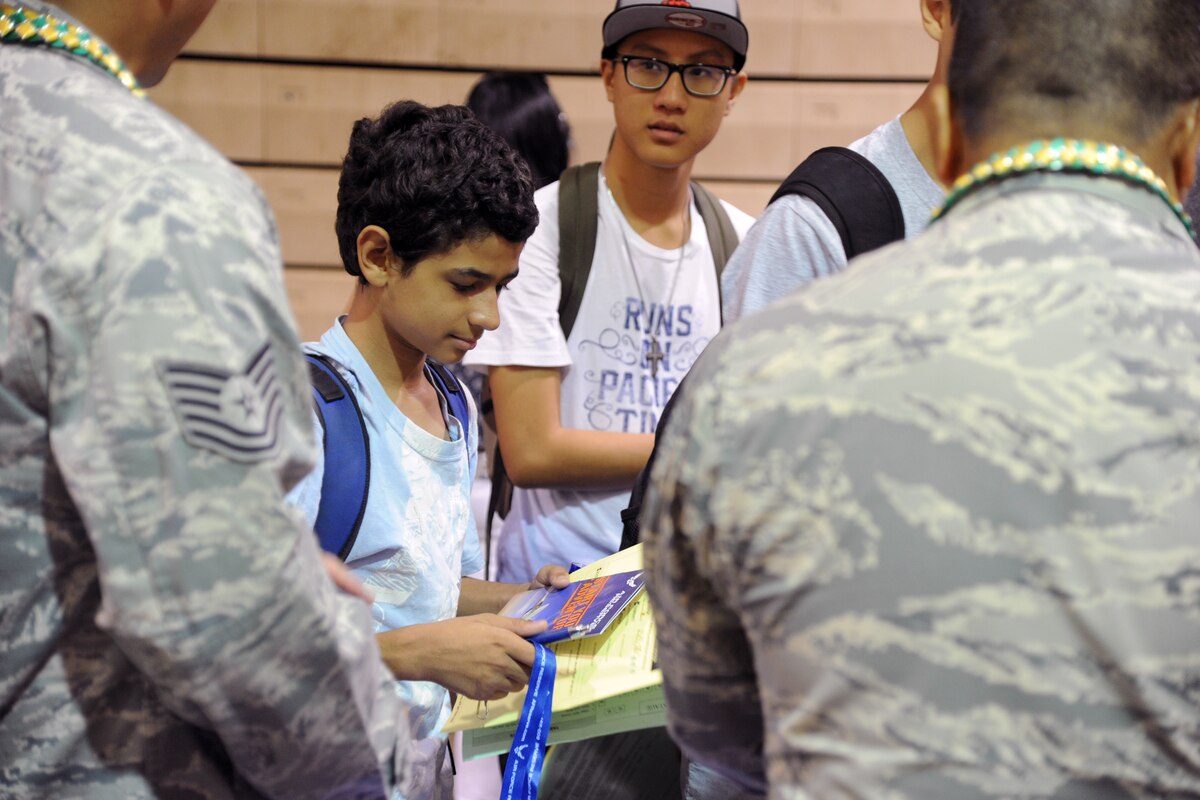August 25, 2022 / Christopher Wilson / Yahoo News - Rep. Jim Banks, R-Ind., said Thursday that President Biden's student loan forgiveness plan will hurt the U.S. military's ability to recruit.
 "Student loan forgiveness undermines one of our military's greatest recruitment tools at a time of dangerously low enlistments," Banks wrote in a tweet as Republicans continue to attack the White House for the announcement that it would be canceling $10,000 in student loan debt for millions of Americans.
"Student loan forgiveness undermines one of our military's greatest recruitment tools at a time of dangerously low enlistments," Banks wrote in a tweet as Republicans continue to attack the White House for the announcement that it would be canceling $10,000 in student loan debt for millions of Americans.
Though the White House is limiting forgiveness to those making under $125,000 per year, conservatives have attempted to paint the plan as a handout to the rich. Banks's comment appears to undercut that message, implying that lower-income Americans might no longer see joining the military as a path to a college education that wealthier families can typically afford without volunteering for service.
 August 23 2022 / Steve Early / Suzanne Gordon / Jacobin - We’ve long known that the US armed forces target poor and working-class students to meet their enlistment goals. But according to a recent report, the military’s JROTC program is also rife with sexual misconduct and outright abuse of young women.
August 23 2022 / Steve Early / Suzanne Gordon / Jacobin - We’ve long known that the US armed forces target poor and working-class students to meet their enlistment goals. But according to a recent report, the military’s JROTC program is also rife with sexual misconduct and outright abuse of young women.
Fifty years ago, no symbol of university complicity with the military angered more students than the on-campus presence of the Reserve Officers’ Training Corps (ROTC). The manpower requirements of the Vietnam era could not be met by conscription, draft-driven enlistments, and the graduating classes of military service academies alone. The Department of Defense also needed commissioned officers trained in DOD-funded military science departments at private and state universities.
Anti-ROTC campaigning became a major focus of the campus-based movement against the Vietnam War. Critics demanded everything from stripping ROTC courses of academic credit to, more popularly, kicking the program off campus. Foot-dragging by college trustees, administrators, and faculty members reluctant to cut ties with the military sparked an escalation of protest activity, from peaceful picketing to more aggressive action. ROTC buildings were trashed, bombed, or set on fire — most famously at Kent State University. There, a May 1970 arson attempt triggered a National Guard occupation that led to the fatal shooting of four students (one of them a ROTC cadet) and then the largest student strike in US history.
The number of sailors who deserted the Navy more than doubled from 2019 to 2021, highlighting the lack of options contract-bound sailors face when they’re desperate to leave. May 18, 2022 / Melissa Chan / NBC News - The number of sailors who deserted the Navy more than doubled from 2019 to 2021, while desertions in other military branches dropped or stayed flat, pointing to a potential Navy-wide mental health crisis amid a spate of recent suicides, according to experts and federal statistics obtained by NBC News.
May 18, 2022 / Melissa Chan / NBC News - The number of sailors who deserted the Navy more than doubled from 2019 to 2021, while desertions in other military branches dropped or stayed flat, pointing to a potential Navy-wide mental health crisis amid a spate of recent suicides, according to experts and federal statistics obtained by NBC News.
Among a fleet of more than 342,000 active sailors, there were 157 new Navy deserters in 2021, compared with 63 in 2019 and 98 in 2020, Navy data shows. The total number of deserters who were still at large in 2021 grew to 166 from 119 in 2019. Most of them were 25 and younger.
“That’s staggering,” said Benjamin Gold, a defense attorney for U.S. service members.
In the wake of several suicides among sailors assigned to the warship the USS George Washington, the new desertion figures highlight the lack of options for sailors when they’re desperate to leave the military but are bound to multiyear contracts that many of them signed just out of high school.
Military law experts said the nearly unbreakable contracts — which can require up to six years of active duty — leave sailors with extreme alternatives: die by suicide or flee and face harsh consequences, including spending years behind bars as patriots-turned-pariahs.
“They feel trapped,” said Lenore Yarger, a resource counselor with the GI Rights Hotline, a nonprofit nongovernmental group that specializes in military discharges.
 May 16, 2022 / Liz Walters / Common Dreams -This past January, student loan company Navient was made to cancel $1.7 billion in federal student debt in a federal settlement judged by Attorney General Maura Healey. The settlement, which also required Navient to distribute $95 million in restitution to approximately 350,000 federal loan borrowers, came after a long fight against the company's predatory lending practices, which promised to help students in need of tuition assistance, and instead steered them towards repayment plans that piled on unnecessary interest. Navient also participated in risky subprime lending without consideration for borrowers and their families, leaving hundreds of thousands of students in crippling debt that the company knew they would not be able to pay back. These shady practices have been going on for at least two decades with little government intervention. The settlement provided loan forgiveness for students who had borrowed between 2002 and 2010. During this time period, Navient, now privatized, was still known as Sallie Mae, an entity created by Congress to service federal loans. As Massachusetts Senator Elizabeth Warren put it: "Navient cheated students who borrowed money to pursue their dreams and allowed them to be crushed by avoidable debt, all while the U.S. Department of Education turned a blind eye."
May 16, 2022 / Liz Walters / Common Dreams -This past January, student loan company Navient was made to cancel $1.7 billion in federal student debt in a federal settlement judged by Attorney General Maura Healey. The settlement, which also required Navient to distribute $95 million in restitution to approximately 350,000 federal loan borrowers, came after a long fight against the company's predatory lending practices, which promised to help students in need of tuition assistance, and instead steered them towards repayment plans that piled on unnecessary interest. Navient also participated in risky subprime lending without consideration for borrowers and their families, leaving hundreds of thousands of students in crippling debt that the company knew they would not be able to pay back. These shady practices have been going on for at least two decades with little government intervention. The settlement provided loan forgiveness for students who had borrowed between 2002 and 2010. During this time period, Navient, now privatized, was still known as Sallie Mae, an entity created by Congress to service federal loans. As Massachusetts Senator Elizabeth Warren put it: "Navient cheated students who borrowed money to pursue their dreams and allowed them to be crushed by avoidable debt, all while the U.S. Department of Education turned a blind eye."
With pandemic restrictions easing, military recruiters are returning to high school campuses while anti-recruitment efforts struggle
 April 18th, 2022 / Roberto Camacho / Prism - The U.S. military utilizes a number of different recruitment methods to garner new enlistments, but their target audience has consistently remained the same: high schoolers, particularly young men from low-income and rural areas. Eighteen is the youngest age one can join the military without parental permission, but the armed forces still regularly market military propaganda in schools. Although the military does enjoy support within the public system, a grassroots movement of students, teachers, parents, and organizations has led efforts to reduce military recruitment presence and activities on high school campuses.
April 18th, 2022 / Roberto Camacho / Prism - The U.S. military utilizes a number of different recruitment methods to garner new enlistments, but their target audience has consistently remained the same: high schoolers, particularly young men from low-income and rural areas. Eighteen is the youngest age one can join the military without parental permission, but the armed forces still regularly market military propaganda in schools. Although the military does enjoy support within the public system, a grassroots movement of students, teachers, parents, and organizations has led efforts to reduce military recruitment presence and activities on high school campuses.
“We face an uphill battle not only because of the prominence of militarism in our society but [also] because there has been a lack of foresight by progressive people who aren’t thinking about what can happen 10 years down the line,” said Rick Jahnkow, former program coordinator for the nonprofit Project on Youth & Non-Military Opportunities (Project YANO) and a current member of the organization’s board of trustees.
The U.S. military has been an all-volunteer service since the end of the draft and the Vietnam War in 1973, making aggressive recruitment efforts essential to maintaining its 1.3 million-member active-duty global military force. Military recruitment in public schools isn’t new, but the level of access the military has to students and their information has increased alarmingly over the past several decades. Notably, recruiters got a significant boost when then-President George W. Bush signed the “No Child Left Behind” Act into law in 2002—under Section 9528 of the act, schools can lose their federal funding if they fail to allow military recruiters the same level of access to students and their private information as they do to other recruiters from community colleges and universities.
Subcategories
Opinion Article Count: 2
The NNOMY Opinion section is a new feature of our articles section. Writing on youth demilitarization issues is quite rare but we have discovered the beginning articles and notes being offered on this subject so we have decided to present them under an opinion category. The articles presented do not necessarily reflect the views of the NNOMY Steering Committee.
Globalization & Militarization Article Count: 1
Military Presence in Our Schools Article Count: 8
Art & Cultural Activism Article Count: 1
The Militarization of U.S. Culture Article Count: 23
 Though the United States of America shares with other nations in a history of modern state militarism, the past 65 years following its consolidation as a world military power after World War II, has seen a shift away from previous democratic characterizations of the state. The last thirty years, with the rise of the neo-conservative Reagan and Bush administrations (2), began the abandonment of moral justifications for democracy building replaced by bellicose proclamations of the need and right to move towards a national project of global security by preemptive military force .
Though the United States of America shares with other nations in a history of modern state militarism, the past 65 years following its consolidation as a world military power after World War II, has seen a shift away from previous democratic characterizations of the state. The last thirty years, with the rise of the neo-conservative Reagan and Bush administrations (2), began the abandonment of moral justifications for democracy building replaced by bellicose proclamations of the need and right to move towards a national project of global security by preemptive military force .
In the process of global military expansion, the US population has been subjected to an internal re-education to accept the role of the U.S. as consolidating its hegemonic rule internationally in the interest of liberal ideals of wealth creation and protectionism.
The average citizen has slowly come to terms with a stealthly increasing campaign of militarization domestically in media offerings; from television, movies and scripted news networks to reinforce the inevitability of a re-configured society as security state. The effect has begun a transformation of how, as citizens, we undertand our roles and viability as workers and families in relation to this security state. This new order has brought with it a shrinking public common and an increasing privatization of publicly held infrustructure; libraries, health clinics, schools and the expectation of diminished social benefits for the poor and middle-class. The national borders are being militarized as are our domestic police forces in the name of Homeland Security but largely in the interest of business. The rate and expansion of research and development for security industries and the government agencies that fund them, now represent the major growth sector of the U.S.economy. Additionally, as the U.S. economy continually shifts from productive capital to financial capital as the engine of growth for wealth creation and development, the corporate culture has seen its fortunes rise politically and its power over the public sector grow relatively unchallenged by a confused citizenry who are watching their social security and jobs diminishing.
How increasing cultural militarization effects our common future will likely manifest in increased public dissatisfaction with political leadership and economic strictures. Social movements within the peace community, like NNOMY, will need to expand their role of addressing the dangers of militarists predating youth for military recruitment in school to giving more visibility to the additional dangers of the role of an influential militarized media, violent entertainment and play offerings effecting our youth in formation and a general increase and influence of the military complex in all aspects of our lives. We are confronted with a demand for a greater awareness of the inter-relationships of militarism in the entire landscape of domestic U.S. society. Where once we could ignore the impacts of U.S. military adventurisms abroad, we are now faced with the transformation of our domestic comfort zone with the impacts of militarism in our day to day lives.
How this warning can be imparted in a meaningful way by a movement seeking to continue with the stated goals of counter-recruitment and public policy activism, and not loose itself in the process, will be the test for those activists, past and future, who take up the call to protect our youth from the cultural violence of militarism.
The "militarization of US culture" category will be an archive of editorials and articles about the increasing dangers we face as a people from those who are invested in the business of war. This page will serve as a resource for the NNOMY community of activists and the movement they represent moving into the future. The arguments presented in this archive will offer important realizations for those who are receptive to NNOMY's message of protecting our youth, and thus our entire society, of the abuses militarism plays upon our hopes for a sustainable and truly democratic society.
NNOMY
Resources Article Count: 2
The Resources section covers the following topics:
International Networking Article Count: 1
Book Reviews Article Count: 5
NNOMY Network News Article Count: 12
News reports from the groups associated to the NNOMY Network including Social Media.
CR Reports Article Count: 5
Reports from counter-recruitment groups and activists from the field. Includes information about action reports at recruiting centers and career fairs, school tabling, and actions in relation to school boards and state legislatures.
CR in the News Article Count: 8
David Swanson Article Count: 6
 David Swanson is the author of the new book, Daybreak: Undoing the Imperial Presidency and Forming a More Perfect Union, by Seven Stories Press and of the introduction to The 35 Articles of Impeachment and the Case for Prosecuting George W. Bush by Dennis Kucinich. In addition to cofounding AfterDowningStreet.org, he is the Washington director of Democrats.com and sits on the boards of a number of progressive organizations in Washington, DC.
David Swanson is the author of the new book, Daybreak: Undoing the Imperial Presidency and Forming a More Perfect Union, by Seven Stories Press and of the introduction to The 35 Articles of Impeachment and the Case for Prosecuting George W. Bush by Dennis Kucinich. In addition to cofounding AfterDowningStreet.org, he is the Washington director of Democrats.com and sits on the boards of a number of progressive organizations in Washington, DC.
Charlottesville Right Now: 11-10-11 David Swanson
David Swanson joins Coy to discuss Occupy Charlottesville, protesting Dick Cheney's visit to the University of Virginia, and his new book. - Listen
Jorge Mariscal Article Count: 2
 Jorge Mariscal is the grandson of Mexican immigrants and the son of a U.S. Marine who fought in World War II. He served in the U.S. Army in Vietnam and currently teaches at the University of California, San Diego.
Jorge Mariscal is the grandson of Mexican immigrants and the son of a U.S. Marine who fought in World War II. He served in the U.S. Army in Vietnam and currently teaches at the University of California, San Diego.
Matt Guynn Article Count: 1
 Matt Guynn plays the dual role of program director and coordinator for congregational organizing for On Earth Peace, building peace and nonviolence leadership within the 1000+ congregations of the Church of the Brethren across the United States and Puerto Rico. He previously served a co-coordinator of training for Christian Peacemaker Teams, serving as an unarmed accompanier with political refugees in Chiapas, Mexico, and offering or supporting trainings in the US and Mexico.
Matt Guynn plays the dual role of program director and coordinator for congregational organizing for On Earth Peace, building peace and nonviolence leadership within the 1000+ congregations of the Church of the Brethren across the United States and Puerto Rico. He previously served a co-coordinator of training for Christian Peacemaker Teams, serving as an unarmed accompanier with political refugees in Chiapas, Mexico, and offering or supporting trainings in the US and Mexico.
Rick Jahnkow Article Count: 8
 Rick Jahnkow works for two San Diego-based anti-militarist organizations, the Project on Youth and Non-Military Opportunities and the Committee Opposed to Militarism and the Draft. He can be reached at: This email address is being protected from spambots. You need JavaScript enabled to view it.
Rick Jahnkow works for two San Diego-based anti-militarist organizations, the Project on Youth and Non-Military Opportunities and the Committee Opposed to Militarism and the Draft. He can be reached at: This email address is being protected from spambots. You need JavaScript enabled to view it.
Pat Elder Article Count: 12
 Pat Elder was a co-founder of the DC Antiwar Network (DAWN) and a member of the Steering Committee of the National Network Opposing the Militarization of Youth, (NNOMY). Pat is currently involved in a national campaign with the Women's International League for Peace & Freedom project, Military Poisons, investigating on U.S. military base contamination domestically and internationally. Pat’s work has prominently appeared in NSA documents tracking domestic peace groups.
Pat Elder was a co-founder of the DC Antiwar Network (DAWN) and a member of the Steering Committee of the National Network Opposing the Militarization of Youth, (NNOMY). Pat is currently involved in a national campaign with the Women's International League for Peace & Freedom project, Military Poisons, investigating on U.S. military base contamination domestically and internationally. Pat’s work has prominently appeared in NSA documents tracking domestic peace groups.
All Documents:
Pat Elder - National Network Opposing the Militarization of Youth
COMMUNITY ACTION Article Count: 2
Network Actions Article Count: 5
EVENTS & CONFERENCES Article Count: 4
NNOMY periodically participates in or organizes events(e.i. conferences, rallies) with other organizations.
CR Activist Reports Article Count: 2
CR Discussion List Article Count: 1
NNOMY in the News Article Count: 13
National CR Database Article Count: 1
GI Resistance Article Count: 1
Conscientious Objection Article Count: 1
NNOMY National Conference Article Count: 11
Materials/Training Article Count: 1
For Educators/Guidance Counselors Article Count: 2
Recruiting on College Campuses Article Count: 1
Model Programs Article Count: 1
School Policies Article Count: 5
EN ESPAÑOL Article Count: 1
Equal access Article Count: 1
NCLB Article Count: 1
MILITARISM & WAR Article Count: 3
FOR ENLISTED PERSONNEL Article Count: 1
FOR PARENTS Article Count: 1
CONSIDERING ENLISTING? Article Count: 1
RECRUITING IN SPECIFIC COMMUNITIES Article Count: 1
MILITARY RECRUITING TOOLS & METHODS Article Count: 3
SCHOOL BASED COUNTER RECRUITMENT Article Count: 6
Know Your Rights Article Count: 2
Delayed Entry Program/DEP Article Count: 1
Alternatives by State Article Count: 1
NNOMY Article Count: 13
ALTERNATIVES TO THE MILITARY Article Count: 3
Facts & Figures Article Count: 1
COUNTER RECRUITING ESSENTIALS Article Count: 1
The Counter-recruitment Essentials section of the NNOMY web site covers the issues and actions spanning this type of activism. Bridging the difficult chasms between religious, veteran, educator, student, and community based activism is no small task. In this section you will find information on how to engage in CR activism in your school and community with the support of the knowledge of others who have been working to inform youth considering enlisting in the military. You will also find resources for those already in the military that are looking for some guidance on how to actively resist injustices as a soldier or how to choose a path as a conscientious objector.
Steering Committee Article Count: 1
Articles Article Count: 227
John Judge Article Count: 5
![]() John Judge was a co-founder of the Committee for High School Options and Information on Careers, Education and Self-Improvement (CHOICES) in Washington DC, an organization engaged since 1985 in countering military recruitment in DC area high schools and educating young people about their options with regard to the military. Beginning with the war in Viet Nam, Judge was a life-long anti-war activist and tireless supporter of active-duty soldiers and veterans.
John Judge was a co-founder of the Committee for High School Options and Information on Careers, Education and Self-Improvement (CHOICES) in Washington DC, an organization engaged since 1985 in countering military recruitment in DC area high schools and educating young people about their options with regard to the military. Beginning with the war in Viet Nam, Judge was a life-long anti-war activist and tireless supporter of active-duty soldiers and veterans.
"It is our view that military enlistment puts youth, especially African American youth, at special risk, not only for combat duty, injury and fatality, but for military discipline and less than honorable discharge, which can ruin their chances for employment once they get out. There are other options available to them."
In the 1970's the Selective Service System and the paper draft became unworkable, requiring four induction orders to get one report. Boards were under siege by anti-war and anti-draft forces, resistance of many kinds was rampant. The lottery system failed to dampen the dissent, since people who knew they were going to be drafted ahead of time became all the more active. Local draft board members quit in such numbers that even I was approached, as a knowledgeable draft counselor to join the board. I refused on the grounds that I could never vote anyone 1-A or eligible to go since I opposed conscription and the war.
At this point the Pentagon decided to replace the paper draft with a poverty draft, based on economic incentive and coercion. It has been working since then to draw in between 200-400,000 enlisted members annually. Soon after, they began to recruit larger numbers of women to "do the jobs men don't want to". Currently recruitment quotas are falling short, especially in Black communities, and reluctant parents are seen as part of the problem. The hidden problem is retention, since the military would have quadrupled by this time at that rate of enlistment, but the percentage who never finish their first time of enlistment drop out at a staggering rate.
I began bringing veterans of the Vietnam War into high schools in Dayton, Ohio in the late 1960s, and have continued since then to expose young people to the realities of military life, the recruiters' false claims and the risks in combat or out. I did it first through Vietnam Veterans Against the War/Winter Soldier Organization, then Dayton Draft & Military Counseling, and since 1985 in DC through C.H.O.I.C.E.S.
The key is to address the broader issues of militarization of the schools and privacy rights for students in community forums and at meetings of the school board and city council. Good counter-recruitment also provides alternatives in the civilian sector to help the poor and people of color, who are the first targets of the poverty draft, to find ways to break into the job market, go to a trade school, join an apprenticeship program, get job skills and placement help, and find money for college without enlisting in the military.
- War Opponents Train For Visits to Area Schools And Recruitment Centers, Michelle Boorstein, Washington Post
- Counter-Recruitment and the Campaign to Demilitarize Public Schools - Scott Harding, Seth Kershner
- C.H.O.I.C.E.S., John Judge
- Interview - John Judge - U.S. Wars & Military Recruitment
- Military and your Schools
- A Celebration of the Life of John Judge May 31, 2014
- In Memory of John Judge - Washington Peace Center
- John Judge- Obituary and request for reflections - Coalition on Political Assassinations (COPA)
- The Loss of John Judge Hits Hard - David Swanson
- John Judge, Leading Change: A Transformational, Quiet Servant Leader, David Ratcliffe
###

